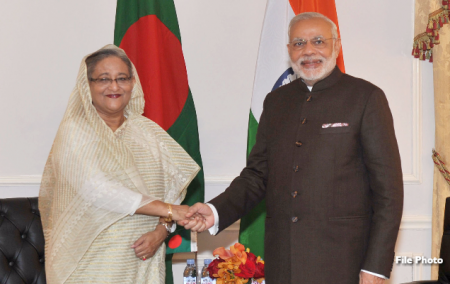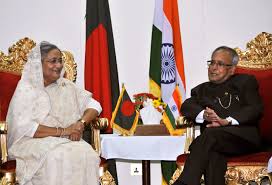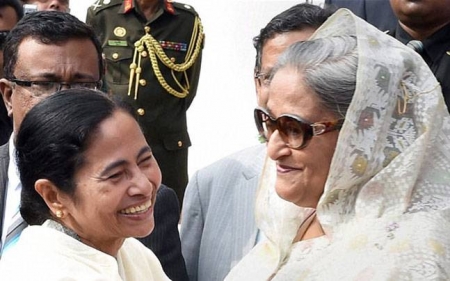| নির্বাচিত পোস্ট | লগইন | রেজিস্ট্রেশন করুন | রিফ্রেস |
Noor Mohammed (Noor)
The current visit of Bangladeshi Prime Minister to India carries an important significance in relations between both neighboring countries. India has unreservedly helped Bangladesh during her war of liberation. India and Bangladesh not only share 4,096 km long common borders but also share the common culture and linguistic diversity over centuries. Together with civilizational, cultural, social and economic associations between India and Bangladesh, the Blackmarket goods, hydrologic and massive political flames also flow through 57 Transboundary Rivers connecting two countries. India and Bangladesh share 2,979 km of land border and 1,117 km of riverine boundaries. The Indian states of West Bengal, Meghalaya, Mizoram, Assam and Tripura share the 4,096-km border with Bangladesh. On the other hand, even though India covers 70 percent of its 4096 km long land boundary with Bangladesh with fences, the traveling of shared history and common heritage, linguistic and cultural ties, passion for music, literature, arts and long-standing affinities between the two sections of the delta remain fenceless.
The last groundbreaking visit of Indian Prime Minister Narendra Modi to Bangladesh signaled an imperative message to the people of both countries and international diplomacy. Both the countries are about to ink an agreement of Teesta River during the visit of PM Narendra Modi to Bangladesh, a stake on which lives of countless people from West Bengal and Bangladesh depend upon for survival. News reports from various sources of not signing an agreement on the water-sharing deal of Teesta during Sheikh Hasian’s current visit apparently remain a disagreement for both nations wherein the both sides are having their popular governments in power. To date, only one comprehensive river pact has been signed by India and Bangladesh when H. D. Deve Gowda and Current Bangladeshi Prime Minister Sheikh Hasina were in power in 1996 on the water-sharing arrangement of the Ganges’ waters at Farakka for a period of thirty years, renewable on the basis of mutual consent.
The relationship started flourishing after the landmark visit of the Prime Minister Sheikh Hasina to India in January 2010 and a return visit by Indian Prime Minister Manmohan Singh to Bangladesh in September 2011 that opened a new chapter in bilateral relation. On his first trip abroad, President Pranab Mukherjee visited Bangladesh in March 2013 since assuming office reflected the highest importance in relationship followed by the visit of Smt. Sushma Swaraj, a reliable friend of Bangladesh as the External Affairs Minister had further cemented momentum to the close and outgoing relationship between India and Bangladesh in 2012, Bangladesh allowed India’s Oil and Natural Gas Corporation to ferry heavy machinery, turbines and cargo through Ashuganj for Palatana Power project in southern Tripura. October 2013, India started exporting 500 megawatts of electricity a day to Bangladesh for a period of 35 years. The two country's Prime Ministers also unveiled the plaque of the 1,320-MW coal-fired Rampal power plant, a joint venture between the two countries. The association is being seen as a major milestone in strengthening the bilateral relationship. Despite all the positivity in the relationship, disagreement in Teesta River waters sharing remain a core issue. In addition, the longstanding issues like Illegal migration, Insurgency, border disputes and border killings of Bangladeshi civilians remain one of the mistrusted disputes distancing two neighborhoods. Implementation of co-firing policy by Indian Security Forces and accountability is vital to safeguard the trust of Bangladeshis that India is not an enemy state but extrovert trusted friendly neighborhood.

The trade disproportions from India’s side must be taken care of. The current volume of bilateral trade is over US$ 7 billion out of which India's export to Bangladesh is about USD 6 billion. This is not a healthy situation wherein Bangladesh remains India’s largest trade partner in South Asia and fifth largest source of remittances to India, being home to a large illegal Indian community. India is all set to voyage as a global power in the years to come and Bangladesh is unreservedly ready to support India’s quest in all international arena. It will be India’s interested to settle all outstanding issues with all neighbor namely with Bangladesh, considering Bangladesh’s strategic importance. In India’s timeline, agreement on water sharing should be given priority. Early resolution of the Teesta issue is indispensable. Connectivity is also a top most priority. The two countries should focus on an agreement on non-tariff barriers. Tactically India should keep Bangladesh away from other strategic partners for her own interest. Furthermore, the Chinese quest for regional power and as well as a global power should be taken into account. This quest is based on the unrelenting and enthusiastic engagement with India’s neighbors for access and basing. Therefore, Bangladesh has been an obvious choice for partnership.

In the recent past, Bangladesh sought Chinese backing in constructing a highway passing through Myanmar to Yunnan province in China. Bangladesh was also reportedly engaged in persuading China to further develop and use the Chittagong port and develop a deep sea port at Sonadia Island. The relationship between China and Bangladesh since 1975 influences Bangladesh to move away from India. Bangladesh maintains a very close relationship with China for its economic and military needs but India must outdo China to demonstrate regional and International leadership.
------------------ The End-------------------
©somewhere in net ltd.